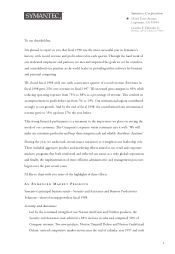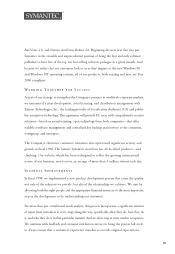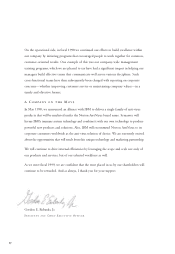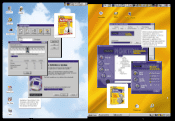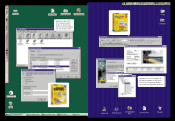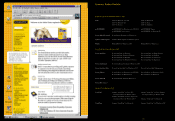Symantec 1998 Annual Report Download - page 15
Download and view the complete annual report
Please find page 15 of the 1998 Symantec annual report below. You can navigate through the pages in the report by either clicking on the pages listed below, or by using the keyword search tool below to find specific information within the annual report.
SYMANTEC CORPORATION
SYMANTEC CORPORATION 1716
Operations - Rapid Technological Change
and Development Risks.)
Operating system vendors such as
Microsoft have added features to new
versions of their products that provide
some of the same functionality traditionally
offered in Symantec’s products. Symantec
believes this trend may continue. Microsoft
may incorporate advanced features in
future versions of operating systems that
may decrease the demand for certain of
the Company’s products, including those
currently under development. In addition,
a number of software developers have
integrated antivirus capabilities into their
Internet products. While Symantec plans
to continue to improve its products with
a view toward providing enhanced func-
tionality over that provided in current
and future operating systems, these efforts
may not be successful and such improved
products may not be commercially accepted
by software users. Symantec will also
attempt to work with operating system
vendors in an effort to make its products
compatible with those operating systems,
yet differentiate those utility products
from features included in the operating
systems. However, these efforts may not
be successful. Other competitors may
license their products to other hardware
and software original equipment manufac-
turers (“OEMs”). In addition, as software
users move toward running programs from
the Internet or over a LAN, the need for
certain of Symantec’s utility programs may
decrease. (See further discussion in Item 7:
Management’s Discussion and Analysis
of Financial Condition and Results of
Operations - Operating System; Microsoft
Windows 98.)
Symantec faces intense competition
in each of the Company’s three business
units: Security and Assistance, Remote
Productivity Solutions and Internet Tools,
Royalties and Other. Examples of key
competitors for business units include:
Security and Assistance
Norton AntiVirus competes with VirusScan
from Network Associates, Inc. (“Network
Associates”), Dr. Solomon’s Anti-Virus
from Dr. Solomon’s Software and Inoculan
from Computer Associates International,
Inc. Norton AntiVirus also competes with
Trend Micro, Inc.’s InterScan VirusWall
and PC-cillin Corp. Edition. Norton
Utilities competes with First Aid and
Oil Change from CyberMedia, Inc.
(“CyberMedia”) and Helix’s Nuts & Bolts
from Network Associates. Norton Uninstall
Deluxe competes with UnInstaller from
CyberMedia and CleanSweep from
Quarterdeck Corporation (“Quarterdeck”).
Norton CrashGuard Deluxe competes with
First Aid 98 Deluxe from CyberMedia, PC
Medic Deluxe from Network Associates and
REALHELP from Quarterdeck. Norton
Your Eyes Only competes with PGPdisk
from Network Associates. Norton Web
Services competes with Oil Change and
First Aid from CyberMedia and TuneUp
and REALHELP from Quarterdeck.
Remote Productivity Solutions
pcANYWHERE competes with LapLink
from Traveling Software, Inc., ReachOut
from Stac, Inc. and Microcom by
COMPAQ Computer Corporation. ACT!
competes with other contact managers, such
as GoldMine from GoldMine Software
Corporation, Maximizer from Maximizer
Technologies, Inc. and Janna Contact from
Janna Systems, Inc. ACT! also competes,
but less directly, with personal information
managers, such as Organizer from IBM’s
Lotus division and Sidekick from Starfish
Software. WinFax competes with
Quarterdeck’s Procomm Plus product line.
Internet Tools, Royalties and Other
Symantec Visual Café (Database
Development Edition) competes with
Borland JBuilder Client/Server from
Inprise Corporation, VisualAge for Java
Enterprise from International Business
Machines (“IBM”) and PowerJ from
Sybase, Inc. Symantec Visual Café
(Professional Development Edition)
competes with Microsoft’s Visual J++,
Inprise’s Borland JBuilder Professional,
IBM’s VisualAge for Java Professional,
SuperCede by SuperCede Inc. and Sun
Microsystem’s Java WorkShop. Symantec
Visual Café (Web Development Edition)
competes with Microsoft’s Visual J++,
Inprise’s Borland JBuilder Professional
and IBM’s VisualAge for Java Standard.
In addition, these and other Company
products compete less directly with a
number of other products that offer levels
of functionality different from those
offered by Symantec’s products or that
were designed for a somewhat different
group of end users than those targeted by
Symantec. Microsoft has incorporated
advanced utilities including telecommu-
nications, facsimile and data recovery
utilities in Windows 95 and may include
additional product features in Windows 98
or future releases of Windows NT that may
decrease the demand for certain of the
Company’s products, including those
currently under development. Additionally,
as hardware vendors incorporate additional
server-based network management and
security tools into network operating sys-
tems, the demand may decrease for certain
of the Company’s products, including
those currently under development. Also,
Symantec’s competitors may license certain
of their products to Microsoft and OEMs
for inclusion in their operating systems,
which may reduce the demand for certain
of the Company’s products. (See further
discussion in Item 7: Management’s
Discussion and Analysis of Financial
Condition and Results of Operations -
Operating System; Microsoft Windows 98.)
Symantec also competes with micro-
computer hardware manufacturers that
develop their own software products.
international CD-ROM manufacturing
is performed by outside contractors in
Dublin, Ireland.
Symantec has often been able to
acquire materials on a volume-discount
basis and has had multiple sources of
supply for certain materials. To date,
Symantec has not experienced any mate-
rial difficulties or delays in production of
its software and related documentation
and packaging. However, shortages may
occur in the future.
Symantec normally ships products
within one week after receiving an order.
Thus, Symantec does not consider
backlog to be a significant indicator of
future performance.
PRICE COMPETITION
Price competition is sometimes intense
with certain products in the microcom-
puter business software market and is
expected to continue to increase and
become even more significant in the
future, and may result in reduced profit
margins. (See further discussion in Item 7:
Management’s Discussion and Analysis
of Financial Condition and Results of
Operations –Price Competition.)
SEASONALITY
While Symantec’s diverse product line
has tended to lessen fluctuations in quar-
terly net revenues, these fluctuations have
occurred and may occur in the future.
These fluctuations may be caused by a
number of factors, including the timing
of announcements and releases of new or
enhanced versions of Symantec’s products
and product upgrades, the introduction
of competitive products by existing or new
competitors, reduced demand for any
given product, seasonality in the end-of-
period buying patterns of foreign software
markets and the market’s transition
between operating systems. These factors
may cause significant fluctuations in net
Further, Symantec competes with other
microcomputer software companies for
access to the channels of retail distribution
and for the attention of customers at the
retail level and in corporate accounts.
Finally, Symantec competes with other
software companies in its efforts to acquire
products or companies and to publish
software developed by third parties.
Symantec believes that competition in
the industry will continue to intensify as
most major software companies expand
their product lines into additional product
categories. Some of the Company’s com-
petitors have substantial financial, marketing
and technological resources. (See further
discussion in Item 7: Management’s
Discussion and Analysis of Financial
Condition and Results of Operations -
Rapid Technological Change and
Development Risks, Operating System
and Retail Distribution Channel.)
MANUFACTURING AND BACKLOG
Symantec’s product development organi-
zation produces a set of master CD-ROMs
or diskettes and documentation for each
product that are then duplicated and
packaged into products by the manufac-
turing organization. Most of Symantec’s
domestic manufacturing is performed by
outside contractors under the supervision
of Symantec’s manufacturing organiza-
tion. Purchasing of most raw materials
and fulfillment of most orders is done by
Symantec personnel in Symantec’s
Sunnyvale, California facility. The manu-
facturing steps that are subcontracted to
outside organizations include the dupli-
cation of diskettes and CD-ROMs,
printing of documentation materials and
assembly of the final package. Symantec
performs diskette duplication and assem-
bly of the final package in its Dublin,
Ireland manufacturing facility for most
products distributed outside of the United
States and Canada. Most of Symantec’s
revenues and, accordingly, operating
results. (See further discussion in Item 7:
Management’s Discussion and Analysis
of Financial Condition and Results of
Operations - Fluctuations in Quarterly
Operating Results and Stock Price.)
Product Protection
Symantec regards its software as propri-
etary and relies on a combination of
copyright, patent and trademark laws and
license agreements in an attempt to pro-
tect its rights. However, Symantec is still
subject to potential legal suits. (See fur-
ther discussion in Item 7: Management’s
Discussion and Analysis of Financial
Condition and Results of Operations -
Intellectual Property Rights, Litigation.)
EMPLOYEES
As of March 31, 1998, Symantec employed
approximately 2,300 people, including
1,200 in sales, marketing and related staff
activities; 600 in product development, and
500 in management, manufacturing,
administration and finance. None of the
employees is represented by a labor union,
and Symantec has experienced no work
stoppages. Symantec believes that its
employee relations are good.
Competition in recruiting personnel in
the software industry is intense. Symantec
believes that its future success will depend
in part on its ability to recruit and retain
highly skilled management, marketing and
technical personnel. Symantec believes
that it must provide personnel with a
competitive compensation package, which
necessitates the continued availability of
stock options and shares to be issued under
the Company’s employee stock purchase
plan, and requires ongoing shareholder
approval of such incentive programs. (See
further discussion in Item 7: Management’s
Discussion and Analysis of Financial
Condition and Results of Operations -
Employee Risk.)


